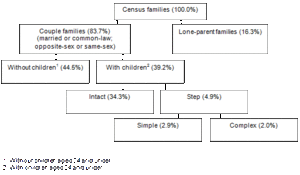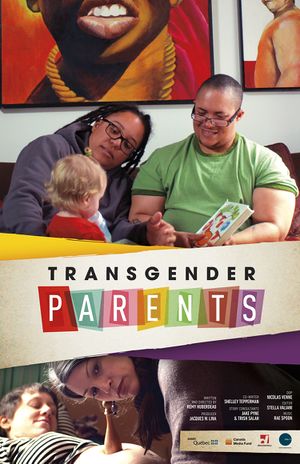Gender Dynamics and Discourses in Parenting

Overview
The Standard North American Family is the ideological code in which a family consists of a marriage, with a mother, a father and children, whom work to supply for the family. Otherwise known as the SNAF, it emphasizes the importance of the primary roles of the father and mother. Society constructs discourses of what "good parenting" looks like. The image shows a Standard North American Family consisting of a mother and father with their two children.

This chart of Census families in 2011 shows that the number of Canadian coupled families without children now outnumber the coupled families with children. This means that it is becoming more common that couples are not having children than those who are. Another factor that ties into that could also be the amount of young adults who are moving out early, and do not live with their parent. 99.2% of children 14 and under live with at least one parent and with at least one grandparent.
Motherhood
The gendered expectations in parenting in heterosexual couples, are that the women should be taking care of the children at home more than the men, because women supposedly are more nurturing, emotional and supportive. If the women are in the labour force, they are seen as the supplementary earner for the male. “Motherhood penalty” is the idea that women with children earn about 12-20% less than mothers without children because it is expected that their primary commitment and role is being the caregiver for the children. In addition, mothers may work less hours thus results in a lesser wage. Either way, women are placed in a double bind because they are punished for not being in work, or that if they are more committed to work, they are also judged because of their priorities to work instead of children.

Good and Bad Mothers
A novel called "Tiger Moms" depicts mothers that are overly controlling and have high expectations due to their lives being intensely structured around activities. Too little or too much involvement can have negative impacts, therefore the right amount of involvement is needed for an appropriate relationship, however it is still unclear about the impacts.
Tensions on Breastfeeding
Since women will generally take time off work to provide this for their children, males are preferred over females for certain positions in the workforce. Even though society is encouraging the discourse of a nurturing mother and the women's sexuality, tensions rise as the body of the women is sexualized, and are criticized for practising this breastfeeding in public. This is an example of a societal contradiction where mother's should be caring for their children and being nurturing, but still must hold true to the "appropriate" female by not showing their body or breast in public.
“They make it tough for working mothers. I don’t know why they have to schedule all of this stud during the day. My first grader is playing a hammerhead shark in his class play – but it’s at 11 in the morning. They scheduled the Mother’s Day Tea on a Friday. But they put Father’s Day Tea on a weekend, of course. The other day my first grader told me how lucky his friend was that his mom didn’t work and could come to everything. That one hurt a little.”
Source: Humans of New York Blog, May 8 2015.

This depicts how society creates the norm that mothers would be more available and have time off from work for the children, therefore puts the Mother’s Day Tea on a weekday. However, for those working mothers like the one above, she was compared to other mothers who were more available for her children. The two events were made according to the societal assumptions where it makes sense that the mother takes the time off because she earns less, has a more flexible schedule or work place, whereas men have higher earning capacities and have a strict schedule to work. These gender narratives constricted this mother who was a working mother.
Fatherhood

In contrary to mothers, dominant norms of the fatherhood and masculinity from society make it more normal for fathers to be the primary income earners in the family, because of their higher earning capacity. These gender narratives are constraining the roles of the father, leaving them to be seen as less knowledgeable and experienced in taking care of the children physically and emotionally. The “Fatherhood bonus” allows fathers to earn more than those who are not fathers. To explain, these fathers get rewarded because they are the primary provider, they are committed to the work, therefore they have more earning power. Classes also play a role in this. Men in higher classes get higher bonuses, and mothers in higher classes get bigger penalties.
Trans Parents

Trans is an umbrella term that consists of transgenders, transsexuals, and gender queer. These identities are somewhere along the spectrum since gender is not a binary concept. Since becoming gay or lesbian has become more acceptable in today's society, more and more parents can be found to be gender non-conformed and hold their own gender identity and expression. This could happen before becoming a parent, or after becoming a parent. The change in gender was only made legal in 2014 through identity documents, but until then, it was difficult to access parenthood for the transgender. Now, more trans parents can access services related to breastfeeding, and assisted conception. Queer parents can have a different dynamic in their life at home. As long as both of sides acknowledge household work as important and diffuse it somewhat equally, there will be less family stress and conflict. This conflict may arise when demands associated with work are incompatible with demands associated with family and life. Of course, both lesbian households and gay households must facilitate and balance work/home responsibilities according to each other's values. There are many challenges with being a biological mother of a child, in which may be expected that they take more time off work, or take on more involvement with parenting. The impact of raising children appears to affect lesbian parents less. 22.3% withdraw from the labour force and 35.5% of women are with dependent children. These implications and challenges invites us to recognize important housework and help us to see the changing gender views and expectations that follow them. A "nurse" compared to a "male nurse" has stigmatizations as if gender was attached to these words. Society should encourage support, and this includes parents themselves, community and peers.

To watch the documentary film Transgender Parents and learn about people's personal stories about how they deal with parenting in their situations, please visit: http://www.transgenderparentsdoc.com/transformingfamily/
Influence on Children
Some negative concerns that are usually brought up may be:
- Children may experience a multitude of difficulties when growing up in the area of sexual identity
- This may cause them to be less psychologically healthy because of the vulnerability of mental breakdowns and behaviour problems.
- They will experience difficulty in social relationships and be targeted in bullying
However, some responses to these arguments include:
- They will be more open to conversation because the topic is evident and being brought up in everyday lives within the family
- If sexuality is innate, then there should be no influence on what the parents are
- There would be family support
https://www.youtube.com/watch?v=FSQQK2Vuf9Q
In the video above, Zach Wahls speaks about his experience and story living with lesbian parents, convincing the audience that his family is "legitimate".
Schools and Institutions
Education is one of the biggest influence on children growing up, influencing their expectations of the norms of mothers and fathers and same-sex marriages. Children are taught these gendered narratives, this content material of boys and girls at an early age, thus giving the children a preconceived schema about the dominance and dynamics of each gender as well as sexual identities. This scheme is then practised or reiterated to some extent, during their childhood, and that forms into a stereotype in the future.

Teachers and Peers
At school, teachers play a big role in what concepts and roles the children learn about. Gender differentiation is usually the biggest thing, since children are learning about what a boy and a girl is, teachers use certain stereotypes and gendered colours and jobs to explain, thus leading to the preconceived idea of boys and girls. A lot of activities have to do with this, since a common way of splitting teams is boys versus girls, and lining up usually incorporates these as well. Children tend to play with groups of peers that are of the same sex. As kids, they use verbal discrimination in games when they exclaim "girls can't play with us, you have long hairs!" or that girls can't play with cars, and boys can't play with dolls. In 2009, almost 90% of transgender youth that were questioned had experienced verbal harassment because of how they expressed themselves. Since children are going through the periods of their life where they learn and absorb the most information, the content that is exposed to them will become a huge influence in their future lives, therefore the stereotypes formed young will fall into a cycle and cause their future teachings to other children to be similar, if they are not aware of the issue.
Awareness
Educators should be trained about the policies that encourage gender discrimination awareness so that the curriculum and lessons taught could be adjusted. This way, the gender stereotypes and traditions are not emphasized or practised upon. For example, teachers can use "good morning, class" instead of "good morning, boys and girls" to minimize the gender attitudes and promotions. These curriculum should restrict gender segregated activities, contexts and attitudes and help teachers to recognize their implicit or explicit behaviour in class which could enforce these.
Conclusion
We must break out of the societal patterns, create a safe space, and begin to educate children about neutral gender dynamics and discourses, with interacting and interchangeable roles, so that children may grow to value both genders as equally hardworking and respecting of each other. In order for this to happen, parents both heteronormative and non-heteronormative can create and maintain a safe space and environment to practise equality in dynamics at work and household, teaching children equality.
References
Huberdeau, Remy, and Rachel Epstein. "ORIGIN." TRANSGENDER PARENTS. LGBTQ Parenting Network, 2013. Web. 05 Aug. 2016. <http://www.transgenderparentsdoc.com/transformingfamily/>
IowaHouseDemocrats. "Zach Wahls Speaks About Family." YouTube. YouTube, 01 Feb. 2011. Web. 05 Aug. 2016.
Lazar, Michelle M. "Gender, discourse and semiotics: The politics of parenthood representations." Discourse & Society 11.3 (2000): 373-400.
Kilman, Carrie. "The Gender Spectrum." Teaching Tolerance. Southern Poverty Law Center, 2013. Web. 3 Aug. 2016.
Martin, Carol L. "Gender: Early Socialization | The Role of Schools in the Early Socialization of Gender Differences |." Encyclopedia on Early Childhood Development. Encyclopedia on Early Childhood Development, Aug. 2014. Web. 05 Aug. 2016.
Portrait of Families and Living Arrangements in Canada." Portrait of Families and Living Arrangements in Canada. N.p., n.d. Web. 25 July 2016.
Pursuing Parenthood: Discourses of Persistence." Science Codex. N.p., n.d. Web. 28 July 2016.
Van Dijk, Teun A. "Discourse & Society: a new journal for a new research focus." Discourse & Society 1.1 (1990): 5-16.